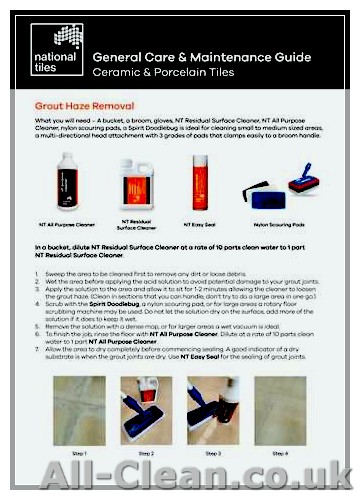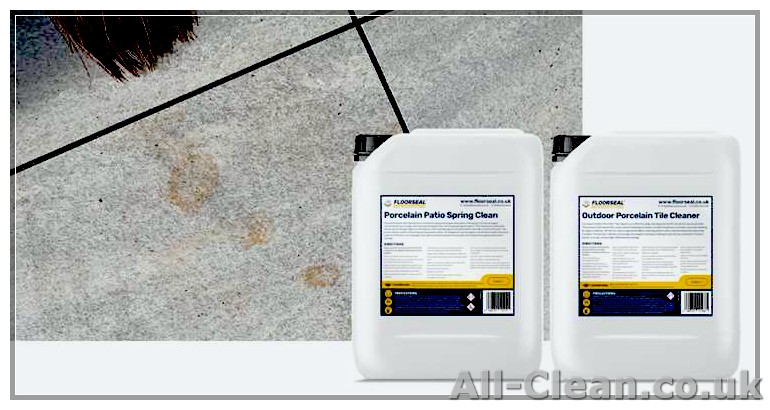
Porcelain and ceramic tiles are a popular choice for both indoor and outdoor spaces due to their durability, low-maintenance nature, and beautiful appearance. However, like any other surface, they do require regular care and cleaning to keep them looking their best. In this guide, we will provide you with some tips on how to effectively clean and maintain your porcelain and ceramic tiles.
When it comes to cleaning porcelain and ceramic tiles, it is important to follow the manufacturer’s instructions. Some tiles may require specific cleaning products or methods, so make sure to read the labels or contact the manufacturer if you are unsure.
For regular cleaning, a simple solution of warm water and a mild detergent will often do the trick. You can mop the floor using a soft mop or microfiber cloth, making sure to wring it out well to avoid excessive moisture. Avoid using excessive amounts of water, as it can seep into the grout lines and promote the growth of mold and mildew.
If you have stubborn stains or marks on your tiles, you may need to use a specialized cleaner. There are many different types of cleaners available on the market, so make sure to choose one that is suitable for your specific tiles. Always test the cleaner on a small, inconspicuous area first to avoid any potential damage to the tiles.
In addition to regular cleaning, it is also recommended to deep clean your porcelain and ceramic tiles on a periodic basis. This can be done using a steam cleaner or a mop with a steam function. Steam cleaning is a super-quick and effective method for removing dirt, grime, and stains from the tiles and grout lines. Just make sure to follow the manufacturer’s instructions and use the steam cleaner on a low setting to avoid any potential damage to the tiles.
When cleaning porcelain and ceramic tiles, it is important to never use wax-based or oil-based cleaners, as they can leave a residue on the surface and make it slippery. Also, avoid using bleach or harsh abrasive cleaners, as they can damage the tiles and grout lines. Instead, opt for gentle and non-abrasive cleaners that are specifically designed for porcelain and ceramic tiles.
In conclusion, regular care and cleaning are essential to maintain the beauty and longevity of porcelain and ceramic tiles. By following the tips and using the right cleaning products, you can keep your tiles looking fresh and new for years to come.
- Methods for Cleaning Porcelain and Ceramic Tiles
- 1. Regular Cleaning
- 2. Removing Stains
- 3. Steam Cleaning
- 4. Outdoor Cleaning
- 5. Matt Tiles
- 6. Epoxy Grout Cleaning
- 7. Cleaning Tips
- An Overview of Different Types of Porcelain Used on Floors and Walls
- 1. Glazed Porcelain
- 2. Polished Porcelain
- 3. Unglazed Porcelain
- 4. Enameled Porcelain
- 5. Textured Porcelain
- Choosing the Right Cleaning Products for Porcelain and Ceramic Tiles
- 1. Determine the Tile Type
- 2. Consider the Surface
- 3. Look for Suitable Cleaners
- 4. Read the Instructions
- 5. Avoid Harsh Cleaners
- 6. Test in a Small Area
- 7. Consider Tile and Grout Cleaners
- 8. Follow Proper Cleaning Techniques
- Tips for Maintaining and Protecting Porcelain and Ceramic Tiles
Methods for Cleaning Porcelain and Ceramic Tiles
1. Regular Cleaning
To keep your porcelain and ceramic tiles looking their best, regular cleaning is essential. Often, sweeping or vacuuming the floor to remove dirt and debris is enough to maintain their cleanliness. This will prevent scratches and protect the surfaces.
2. Removing Stains
If you come across stubborn stains or marks on the tiles, use appropriate cleaning supplies. Avoid using abrasive cleaners or harsh chemicals as they can damage the surface of the tiles. Instead, opt for mild detergents or specialized tile cleaners that are safe for porcelain and ceramic surfaces.
3. Steam Cleaning
Steam cleaning can be used to effectively clean and disinfect porcelain and ceramic tiles. This method is particularly useful for removing allergens and bacteria from the flooring. Simply use a steam cleaner on a low setting and move it across the tiles for a thorough clean.
4. Outdoor Cleaning
Outdoor porcelain and ceramic tiles may require more intensive cleaning, especially if they are exposed to weather elements and outdoor activities. Use a brush or nylon scrub pad with water and mild detergent to remove dirt and stains. Rinse the tiles immediately after cleaning to avoid residue build-up.
5. Matt Tiles
If you have matt tiles, be cautious with the cleaning products you choose. Some cleaners may leave marks or hazes on the surface. It is recommended to test any new cleaner on a small, inconspicuous area before applying it to the entire floor.
6. Epoxy Grout Cleaning

If your tiles have epoxy grout, pay special attention to cleaning the grout lines. Use a toothbrush or nylon brush with a mild cleaning solution to clean the grout. Avoid using abrasive cleaners or stiff brushes that can damage the grout or tiles.
7. Cleaning Tips
Here are some additional tips for cleaning porcelain and ceramic tiles:
- Always use a soft mop or cloth to avoid scratching the tiles.
- If you have pets, regular cleaning is important to remove any pet hair or stains.
- For a thorough clean, sweep or vacuum the floor before mopping.
- When using cleaning products, follow the instructions on the label and use them in well-ventilated areas.
- For internal tiles, consider using mild, pH-neutral cleaning products made specifically for internal use.
- Immediately clean up any spills to prevent stains from setting into the tiles.
- If you’re unsure about a cleaning method, consult the tile manufacturer or a professional cleaner for guidance.
In a nutshell, cleaning porcelain and ceramic tiles requires regular maintenance, the use of appropriate cleaning supplies, and proper cleaning techniques to keep them looking beautiful and free from dirt and allergens.
An Overview of Different Types of Porcelain Used on Floors and Walls
Porcelain is a very popular choice for both interior floors and walls due to its durability and aesthetic appeal. There are different types of porcelain used in these applications, each with its own characteristics and cleaning requirements. This article will provide an overview of the various types and offer tips on how to properly clean and maintain them.
1. Glazed Porcelain
Glazed porcelain tiles are the most common type used on floors and walls. They have a protective layer or glaze applied to the surface, which makes them resistant to stains, water, and scratches. To clean glazed porcelain, start by sweeping or vacuuming to remove any dirt or debris. Then, use a mild detergent or a pH-neutral cleaner mixed with water to wipe down the tiles. Avoid using abrasive cleaners or scrub brushes that could scratch the glaze.
2. Polished Porcelain
Polished porcelain tiles have a shiny, reflective surface that adds a touch of elegance to any space. However, this type of porcelain is more susceptible to scratching and staining compared to glazed porcelain. To clean polished porcelain, sweep or vacuum to remove loose dirt. Use a pH-neutral cleaner diluted with water and a soft mop or cloth to wipe down the surface. Avoid using abrasive cleaners or harsh chemicals that could damage the polish.
3. Unglazed Porcelain
Unglazed porcelain tiles have a natural, matte finish. They are more porous than glazed or polished porcelain, making them more prone to staining. To clean unglazed porcelain, sweep or vacuum to remove dirt and dust. Use a pH-neutral cleaner diluted with water and a stiff brush or mop to scrub the surface. For tougher stains, you can use a mild bleach solution, but be sure to test it in an inconspicuous area first.
4. Enameled Porcelain
Enameled porcelain tiles have a colored glaze applied to the surface, giving them a unique decorative look. They are similar to glazed porcelain in terms of cleaning and maintenance. Sweep or vacuum to remove dirt, then use a mild detergent or pH-neutral cleaner mixed with water to wipe down the tiles. Avoid abrasive cleaners or tools that could scratch or damage the glaze.
5. Textured Porcelain

Textured porcelain tiles have a non-slip surface, making them ideal for outdoor or wet areas. They can be slightly more challenging to clean due to the texture. Start by sweeping or vacuuming to remove loose dirt and debris. Then, use a mild detergent or pH-neutral cleaner diluted with water and a stiff brush to scrub the surface. Rinse thoroughly to remove any residue or cleaner.
By following these cleaning tips and using the appropriate cleaning agents for each type of porcelain, you can effectively clean and maintain your porcelain floors and walls, keeping them free from stains, hazes, and allergens. Remember to always test cleaning products in a small, inconspicuous area before applying them to the entire surface.
Choosing the Right Cleaning Products for Porcelain and Ceramic Tiles
When it comes to cleaning your porcelain and ceramic tiles, using the right cleaning products is essential. The wrong products can cause damage to the tiles, leaving them looking dull and worn. Here are some tips to help you choose the right cleaning products for your tiles.
1. Determine the Tile Type
The first step in choosing the right cleaning products is to determine the type of tile you have. Porcelain and ceramic tiles have different cleaning requirements, so it’s important to know which type you have before selecting a cleaner.
2. Consider the Surface

Another factor to consider when choosing cleaning products is the surface of the tiles. Glossy tiles are more resistant to stains and are easier to clean, while matt tiles can be more susceptible to staining. If you have matt tiles, you may need to use a more powerful cleaner to remove stubborn stains.
3. Look for Suitable Cleaners
There are a variety of cleaning products available for porcelain and ceramic tiles. Some common options include tile and grout cleaners, multi-purpose cleaners, and natural or homemade cleaners. Consider your preferences and the specific needs of your tiles when selecting a cleaner.
4. Read the Instructions
Before using any cleaning product, it’s important to read and follow the instructions carefully. Different cleaners may have specific dilution ratios or application methods that you need to follow to achieve the best results.
5. Avoid Harsh Cleaners
While it may be tempting to use strong, abrasive cleaners to tackle tough stains, it’s best to avoid harsh chemicals that can damage your tiles. Opt for mild, non-abrasive cleaners that are specifically formulated for use on porcelain and ceramic tiles.
6. Test in a Small Area
If you’re unsure about a particular cleaner, it’s always a good idea to test it in a small, inconspicuous area before using it on the entire tiled surface. This will help you determine if the cleaner is safe for your tiles and if it effectively removes stains.
7. Consider Tile and Grout Cleaners
In addition to cleaning the tiles themselves, it’s important to pay attention to the grout between the tiles. Over time, grout can become dirty and discolored. Look for tile and grout cleaners that are specifically designed to tackle grout stains and maintain its cleanliness.
8. Follow Proper Cleaning Techniques
Finally, to maintain clean and beautiful porcelain and ceramic tiles, it’s important to follow proper cleaning techniques. This includes regularly sweeping or vacuuming the tiles to remove dirt and debris, using a damp mop with a suitable cleaner, and quickly wiping up any spills or stains to prevent them from setting in.
By following these guidelines and choosing the right cleaning products, you can keep your porcelain and ceramic tiles looking their best and enjoy a clean and hygienic home.
Tips for Maintaining and Protecting Porcelain and Ceramic Tiles
- Regularly sweep or vacuum the tiles to remove loose debris and dirt.
- Use a mild, pH-neutral detergent to clean the tiles. Avoid using abrasive cleaners or harsh chemicals, as they can damage the surface.
- If you notice any stains or grime, you can create a homemade cleaning solution using warm water and a few drops of dish soap.
- Test any cleaning products on a small, inconspicuous area of the tiles before applying them to the entire surface.
- For textured tiles, use a soft-bristle brush to scrub away tougher stains or dirt. Avoid using stiff brushes or abrasive pads, as they can scratch the surface.
- Wipe down the tiles with a damp cloth or mop after cleaning to remove any residue.
- For tough stains or grout lines, you can use a steam cleaner to help loosen and remove the dirt. Just make sure to follow the manufacturer’s instructions.
- Avoid using wax or polish on porcelain or ceramic tiles, as they can make the surface slippery and prone to accidents.
- If you have newly laid tiles, wait at least 48 hours before cleaning them to allow the grout to fully dry.
- When cleaning kitchen tiles, pay special attention to areas near the stove and sink, as they can accumulate grease and food particles.
- To prevent the growth of bacteria and keep the tiles hygienic, regularly disinfect them using a suitable disinfectant solution.
- If you have resin-based tiles, you can usually clean them with a damp cloth or mop. Avoid using abrasive materials that can scratch the surface.
- To remove stubborn stains, you can purchase specialized tile cleaning products that are specifically designed for porcelain and ceramic tiles.
- For low-maintenance tile care, invest in a high-quality tile sealer. This will help protect the tiles from stains and make them easier to clean.
- Make sure to wipe up spills, particularly acidic or colorful liquids, immediately to prevent staining.
- If you’re unsure about the best cleaning method for your tiles, seek advice from the tile manufacturer or a professional cleaner.








